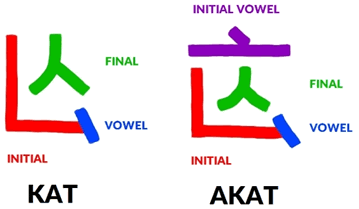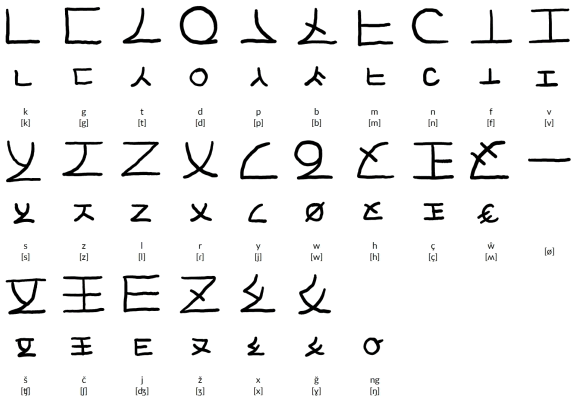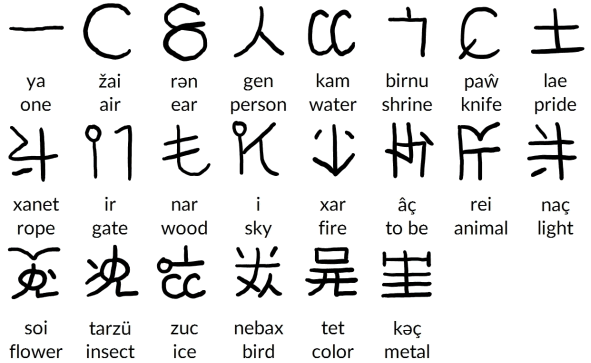The Naric script was invented by Jeffrey Recinos around 2010. It appears to be inspired by Japanese Kanji, but in actuality it originated from random sketches. The script has since undergone many refinements to appear more like a modern script. The Naric script is used to write Naric, the fifth-most spoken language on the fictional planet of Kadara; and its sister language, Döxnaric (Pronounced “duck-naric”) among the countries of Naria and Döxnaria, respectively. There are two written methods of Naric used in conjunction with one another: the alphabet (Takerše), and the semanto-phonetic script (Genše)
The Naric script is a direct descendant of the older Gagrite script, with many Naric letters sharing many similarities with Gagrite letters. While the history of the alphabet is well known among Naric historians, it is unclear where Genše originated from. Many historians believe that most logographic Genše originated from the various abbreviations used by ancient Gagrites found in many documents. Three styles were used before its current form took place: Boulder Naric (tângše - Gagrite characters used to write Ancient Naric), Sand Naric (oçše – predecessor to the Modern Naric script), and River Naric (miše – the cursive form of Naric still used in decorative art today). Naric has also evolved to suit the Döxnaric language as well.
The Naric alphabet is written in a syllable block style, similar to that of Korean Hangul. Almost every syllable will contain an initial consonant and medial vowel attached to the consonant; some will contain a final consonant as well. Special initial forms for vowels are also used if a syllable begins with a vowel.

If an initial vowel is attached to a syllable, that vowel becomes part of that syllable. Therefore, "akat" is interpreted as a single syllable. With an initial vowel, you can drop the medial vowel from the initial consonant (making a syllable like "aka" just "ac").
The Naric alphabet consists of 26 initial consonants (excluding ng) known as Aberaç, and 26 final consonants excluding [ø] known as Pesraç,

The initial ç is pronounced as a consonant ([ç]), but as a final makes the vowel pronounced as a breathy ejective ([ø̤], almost sounding like [h]. The same goes for ŵ: pronounced as a semivowel if initial ([ʍ]), but diphthongizes the preceding vowel if used as a final ([øṳ])
The Naric alphabet contains 10 vowels, each with its distinctive initial and medial forms.

Naric numerals are considered Genše. Yung (0) has two forms: the first being the informal way of writing, and its official Genše, used in formal works or official documents. Any numerals that are a multiple of 10 or 100 are written with their respective Genše:


Naric Genše are distinct characters used alongside the standard alphabet, much like Japanese kanji. There are five different types of Genše.
Used to represent an idea like a numeral.
![]()
Used to represent a physical object. Many Genše radicals double as pictographs.

The most common type; these use radicals to give an idea of what the character is referring to.

Does not represent any idea or picture, simply expresses a word or a particle which normally couldn’t use a logographic or ideographic character.

Similar to logographic characters, but instead uses Naric syllables to help with both context and pronunciation.

There are 51 official radicals used in Genše which make up virtually all Genše. The list is organized via stroke count. Here are a selection of Genše radicals:

While there is no incorrect way to write a Genše, many Naric schools use a Recommended Stroke Order as a guide to writing a Genše. The general rules are: Genše radicals are written either left-to-right or top-to-bottom.
Most Genše will have one to two pronunciations: The first usually indicates the character is a noun, adjective, adverb, etc. The second pronunciation identifies it as a verb. These pronunciations are used in context to distinguish between verbs and the other forms of speech. Unlike kanji, where the pronunciation depends on where the character is placed in a compound and has many exceptions, Genše will always have the same pronunciation no matter where the Genše is placed within a compound as long as it fits within the context of a sentence.


Vei etaniyu, veigonexda âç.
I think, therefore I am.

Seç âçgeniçxademâç mahourəxu goilat dex žartoninveç jerröt dex nəŵtonin. Giâç röçlaixusəu haitoŵ dex sirbeut dex goribunaxçeç pexnitamiveç širguöm miyaâu.
(Yabinecöm torkoilae motmenöm nəŵtoniniçxadem)
All human beings are born free and equal in dignity and rights. They
are endowed with reason and conscience and should act towards one another
in a spirit of brotherhood.
(Article 1 of the Universal Declaration of Human Rights)
If you have any questions about the Naric script or language, you can contact Jeffrey at languo7@live.com
Gagrite, Naric, Simtex, Todocisian, Tolianem
Constructed scripts for: Ainu | Arabic | Chinese languages | Dutch | English | Hawaiian | Hungarian | Japanese | Korean | Lingala | Malay & Indonesian | Persian | Tagalog / Filipino | Russian | Sanskrit | Spanish | Taino | Turkish | Vietnamese | Welsh | Other natural languages | Colour-based scripts | Tactile scripts | Phonetic/universal scripts | Constructed scripts for constructed languages | Adaptations of existing alphabets | Fictional alphabets | Magical alphabets | A-Z index | How to submit a constructed script
[top]
You can support this site by Buying Me A Coffee, and if you like what you see on this page, you can use the buttons below to share it with people you know.

If you like this site and find it useful, you can support it by making a donation via PayPal or Patreon, or by contributing in other ways. Omniglot is how I make my living.
Note: all links on this site to Amazon.com, Amazon.co.uk
and Amazon.fr
are affiliate links. This means I earn a commission if you click on any of them and buy something. So by clicking on these links you can help to support this site.
[top]